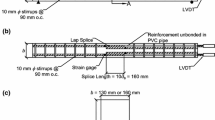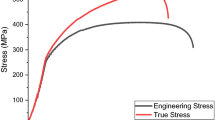Abstract
A novel joining method for permanent formwork, involving the embedment of GFRP in high-strength fiber reinforced cementitious composites (HSFRCC), is proposed. Direct pull-out test is carried out to investigate the bonding capacity between the HSFRCC and GFRP reinforcement. From the experimental data, interfacial parameters are extracted for calculating the required embedded length of GFRP bars to ensure sufficient bonding capacity. According to the test results, the required embedded length of GFRP bars is obtained and the joint width thus can be determined. To further verify the joining method, beam members made with joined and monolithic PDCC formwork are prepared and tested under four point bending. The comparison indicates only about 5 % difference between the load capacities in the two cases. Besides, the worse scenario in the test that the joint was placed at the location with the maximum moment would rarely happen in practice.
















Similar content being viewed by others
References
Bentur A, Diamond S, Berke N (1997) Steel corrosion in concrete: fundamentals and civil engineering practice, 2nd edn. E & FN Spon, New York
Birelli G, Cadoret G, Dutaillor F, Thibaud T (1998) A new, very high performance concrete. In: International symposium on high-performance and reactive powder concretes, vol 3, pp 177–201
Brameshuber W, Brockman J, Rossler G (2001) Textile reinforced concrete for formwork elements—investigation of structural behaviour. In: Burgoyne C (ed) Proceedings of FRPRCS-5, pp 1019–1026
BS 8110-1 (1997) British standard: structural use of concret. Part 1: code of practice for design and construction
Chana P (1990) A test method to establish a realistic bond stress. Mag Concr Res 24(151):83–90
Cheung AKF, Leung CKY (2011) Effective joining of pre-cast concrete slabs with self-compacting HSFRCC. Jpn Concr Inst J Adv Concr Technol 9(1):1–9
Jensen BC et al (1995) Connections in precast buildings using ultra high-strength fibre reinforced concrete. In: Nordic symposium on modern design of concrete structures, Aalborg University, Denmark
Leung CKY, Cao Q (2010) Development of pseudo-ductile permanent formwork for durable concrete structures. RILEM Mater Struct 43(7):993–1007
Leung CKY (1996) Design criteria for pseudo-ductile fiber composites. ASCE J Eng Mech 122(1):10–18
Li VC (1993) From micromechanics to structural engineering—the design of cementitious composites for civil engineering applications. JSCE J Struct Mech Earthquake Eng 10(2):37–48
Li VC, Leung CKY (1992) Steady state and multiple cracking of short random fiber composites. ASCE J Eng Mech 188(11):2246–2264
Miyazato S, Hiraishi Y (2004) Transport properties and steel corrosion in ductile fiber reinforced cement composites. In: Proceedings of 11th international conference on fracture, Paper No. 4484, CD ROM
Li Z, Mobasher B, Shah SP (1991) Characterization of interfacial properties in fiber-reinforced cementitious composites. J Am Ceram Soc 74(9):2156–2164
Ma J, Dietz J (2002) Ultra high performance self compacting concrete. Lacer 7:33–42
Naaman AE (2003) Strain hardening and deflection hardening fiber reinforced cement composites. In: Naaman AE, Reinhardt HW (eds) High performance fiber reinforced cement composites (HPFRCC-4). RILEM Publications, Pro 30, pp 95–113
Ogawa A, Hitomi Y, Hoshiro H (2006) PVA-fiber reinforced high performance cement board. In: Fischer G, Li VC (eds) Proceedings of international RILEM workshop on HPFRCC in structural applications, pp 243–251
Parameswaran VS, Krishnamoorthy TS, Balasubramanian K (1990) Behaviour of high volume fibre cement mortar in flexure. Cement Concr Compos 12:293–301
Richard P, Cheyrezy M (1995) Composition of reactive powder concretes. Cem Concr Res 25(7):1501–1511
Shioya T et al (1997) Pre-cast concrete joint using steel fiber reinforced high strength mortar and/or H-beam. Proc Jpn Concr Inst 19(2):1305–1310
Stang H, Li Z, Shah SP (1990) Pull-out problem: stress versus fracture mechanical approach. Eng Mech ASCE 116(10):2136–2150
Takewaka K, Yamaguchi T, Maeda S (2003) Simulation models for deterioration of concrete structures due to chloride attack. J Adv Concr Technol 1(2):139–146
Wang K, Jansen D, Shah S, Karr A (1997) Permeability study of cracked concrete. Cem Concr Res 27(3):381–393
Windisch A (1985) A modified pull-out test and new evaluation methods for a more real local bond-slip relationship. Mater Struct 18(3):181–184
Yamada K, Saijo R, Furumura T, Tanaka S (2006) Application of extrusion molded DFRCC to permanent form. In: Fischer G, Li VC (eds) Proceedings of international RILEM workshop on HPFRCC in structural applications, pp 253–260
Yang EH, Yang YZ, Li VC (2007) Use of high volumes of fly ash to improve ECC mechanical properties and material greenness. ACI Materials J 104(6):620–628
Yu C, Leung CKY, Cao Q (2010) Behavior of concrete members constructed with SHCC/GFRP permanent formwork. In: Proceedings of 7th international conference on fracture mechanics of concrete and concrete structures, CD ROM
Yudenfreund M, Odler I, Brunauer S (1972) Hardened Portland cement pastes of low porosity, I. Materials and experimental methods. Cem Concr Res 2(3):313–330
Acknowledgments
Financial support of the work by the Hong Kong Research Grant Council, under CERG UST615508, is gratefully acknowledged.
Author information
Authors and Affiliations
Corresponding author
Rights and permissions
About this article
Cite this article
Jin, Q., Leung, C.K.Y. & Yu, C. Effective joining method for pseudo-ductile permanent formwork. Mater Struct 46, 345–360 (2013). https://doi.org/10.1617/s11527-012-9905-3
Received:
Accepted:
Published:
Issue Date:
DOI: https://doi.org/10.1617/s11527-012-9905-3




